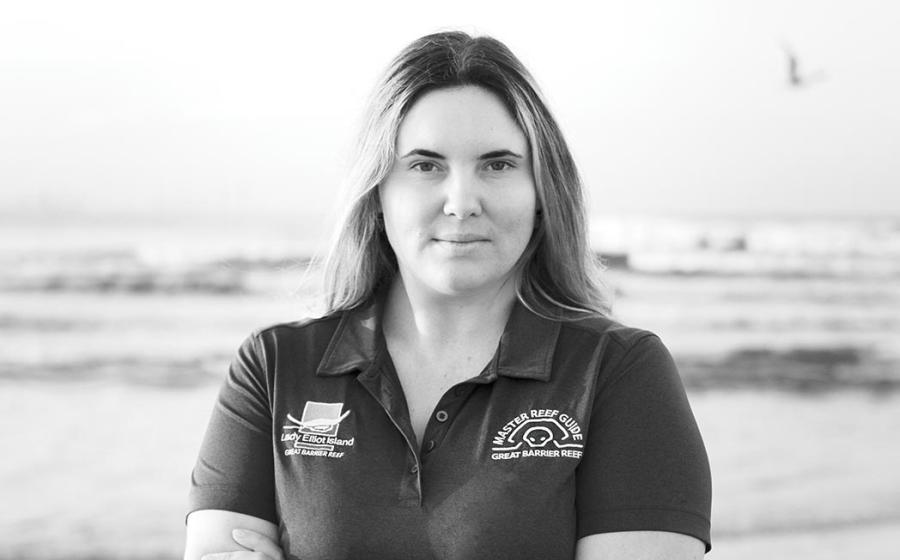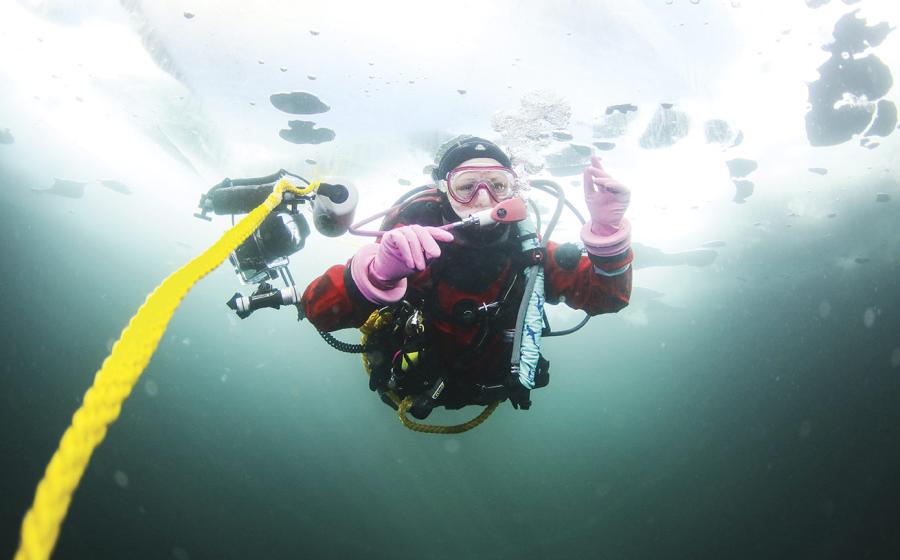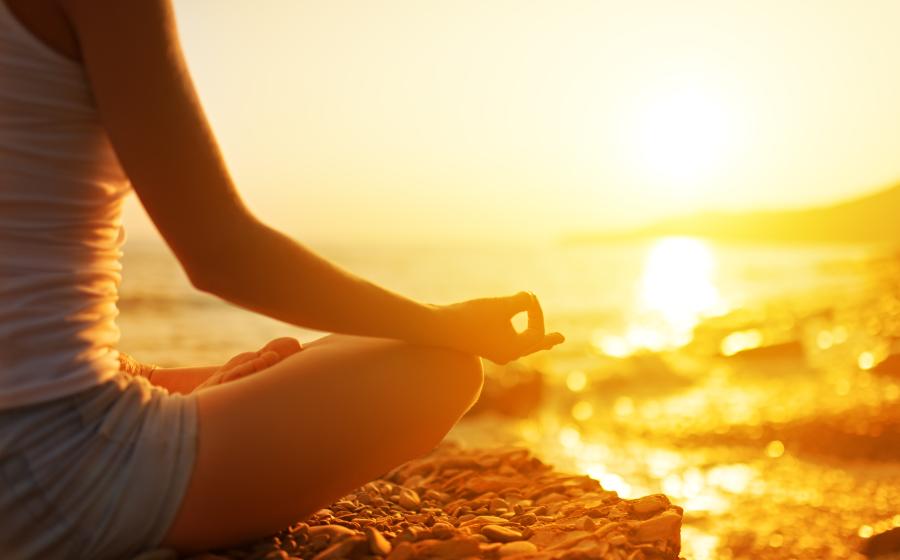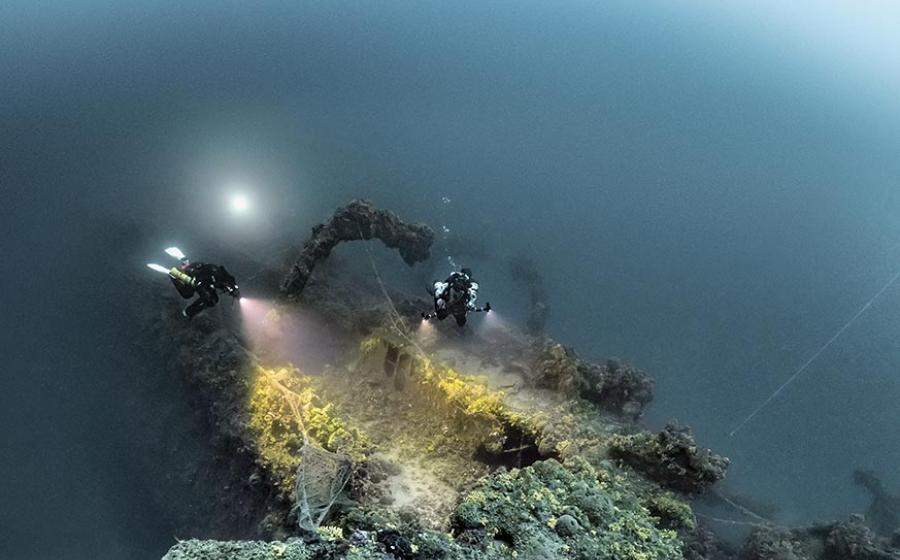The Over-Under: Tools and Techniques
||
|---|
|  |
|
| For an over/under to be effective, there needs to be some underwater component very near the surface, plus something of interest topside--the corals and gorgonians found just beneath the surface at Captain Tom's Wreck in Key Largo contrast with the sky.|
The technique of combining the underwater view with a glimpse of the topside world, all in a single frame, is known as a "split" or an "over/under." While this is one of the more powerful tools in the photojournalistic arsenal, it takes special equipment, skills and environmental conditions to make it happen.
Physics 101
As every diver knows, light changes once it hits seawater. In a medium approximately 800 times more dense than air, light is refracted, absorbed and selectively filtered as a function of depth.
Shoot at Midday--Reason #1
Even under optimal conditions of midday light and clear water, there will be a half- to a full-stop decrease in light level under water compared to topside. Early morning and late afternoon bring sunlight that strikes the ocean surface at an oblique angle and is therefore reflected and absorbed, making as much as a three f-stop difference. For most over/under applications, shoot when the sun is high in the sky, from about 10 a.m. to 2 p.m.
Shoot at Midday--Reason #2
Waves of light travel in straight lines as they pass through air, but when they strike a medium with a greater refractive index (the refractive index of air is 1 and that of water is 1.33), light rays can bend and magnify. This is why things appear to be one-third larger under water. If the light waves strike the water at right angles (when the sun is directly overhead), they are not deflected nearly so much as when they hit at an angle. This is yet another reason to shoot over/unders at midday.
Cameras: Nikonos Out, Housed SLR In
Nikonos lenses are water contact formulations. Even though the 15mm lens for the Nikonos V or the 13mm lens for the RS are wide enough, and excellent for the underwater part of the over/under, they can't focus above water. A housed SLR camera with a dome port is required for over/under shots.
Lens: Full-Frame Fisheye
||
|---|
|  |
|
| This is an over/under taken in a swimming pool with a 16mm full-frame fisheye in a Seacam housing. Note the curving horizon, typical of a fisheye. Many scenes don't have straight lines along the horizon, and therefore make any distortion transparent.|
The easiest way to shoot over-unders is with a full-frame fisheye (16mm for Nikon, 15mm for Canon shooters). The depth of field with these lenses is extraordinary; an aperture of f-8 or smaller is usually sufficient to hold focus on both the topside and the underwater scene. I usually focus on the underwater portion of the scene, usually the most compositionally important part of the image, and let the topside part go a little soft if necessary.
Also, with the fisheye lens, you have the choice of vertical or horizontal compositions since there is no filter to contend with. The water/air interface can be anywhere in the frame. In fact, I often compose with two-thirds of the frame devoted to the underwater portion. Finally, the fisheye is more forgiving of surface chop or swell.
Fisheye: The Downside
Fisheye lenses are prone to excessive distortion, so subjects too near the lens can look unnatural. Also, there is no correction for the light difference between the topside and underwater subjects. If the underwater subject is a shallow reef with lots of reflecting sand, the f-stop difference may be very slight, in which case you would expose for the highlights (topside) and let the underwater portion record slightly dark. In other situations, you can use strobes to bring up the exposure value of the underwater scene to more closely match topside.
Split Diopter: Balance the Light
The split diopter is a special filter that balances the light between the topside and underwater view, while at the same time allowing the underwater portion to focus on the virtual image. This is accomplished with a neutral density piece of glass on the top (to hold back the sunlight and make it more closely approximate the light on the underwater scene) and a diopter (usually in the range of a +3 or +4) to balance the focus. The problem is that if the wide-angle lens is focused on the virtual image for the underwater portion of the frame (e.g., 16 inches for an eight-inch dome), anything beyond about a couple of feet away topside would be out of focus. The solution is to allow the lens to focus nearly on infinity above water, but use the strength of the magnifying lens on the bottom half to pull focus back to the virtual image.
Split Diopter: The Downside
The filter cannot be rotated under water, so the photographer must decide whether the roll will be devoted to verticals or horizontals. Also, because of the way the filter is ground and glued into the filter ring, the split between topside and underwater must be exactly symmetrical, with one-half exactly above and below. If the seas are not slick calm, this can be extremely challenging.
An optician can design a split diopter for you, or you can do it the easy way and order one through any Subal dealer. Check www.subal.com for details.
Dome Size Does Matter
||
|---|
|  |
|
| The ultimate over/under tool: the Seacam housing with a Swivel 45 degree viewfinder and nine-inch mineral glass dome. This viewfinder enlarges the image on the glass, allowing photographers to keep their head out of the water when shooting over/unders.|
The size of the dome is a significant factor in effective over/unders. Aside from the location of the virtual image, larger domes are more forgiving of water surface imperfections. Surface chop is spread over a larger area, making a nine-inch dome far more manageable than a six-inch dome.
Glass versus Plexiglas
For the ultimate over/under tool, insist on a mineral glass dome port. Besides the obvious optical purity, glass allows the water to sheet off the topside portion of the dome far more quickly than Plexiglas, thereby minimizing annoying water droplets.
The Virtual Image
The optics required for an over/under must be housed in a dome port. When a dome port is used under water (in this case half the dome is under water), the dome creates a mysterious image known as a "virtual image." Usually this image is located at a distance of about twice the diameter of the dome from the film plane: a six-inch dome will have a virtual image 12 inches from the film plane; a nine-inch dome at about 18 inches, etc. If a lens cannot focus near enough under water to render the virtual image, it can't focus at all. This is the reason some zoom lenses lacking near-focus capability can't be used behind a dome port without adding a close-up lens.
Stephen Frink is an instructor for the Nikon School of Underwater Photography and RSD's photography director. Questions should be submitted via e-mail to [email protected], web: www.stephenfrink.com, or fax: (305) 451-5147.
|| |---|
| |
| For an over/under to be effective, there needs to be some underwater component very near the surface, plus something of interest topside--the corals and gorgonians found just beneath the surface at Captain Tom's Wreck in Key Largo contrast with the sky.|
The technique of combining the underwater view with a glimpse of the topside world, all in a single frame, is known as a "split" or an "over/under." While this is one of the more powerful tools in the photojournalistic arsenal, it takes special equipment, skills and environmental conditions to make it happen.
|
| For an over/under to be effective, there needs to be some underwater component very near the surface, plus something of interest topside--the corals and gorgonians found just beneath the surface at Captain Tom's Wreck in Key Largo contrast with the sky.|
The technique of combining the underwater view with a glimpse of the topside world, all in a single frame, is known as a "split" or an "over/under." While this is one of the more powerful tools in the photojournalistic arsenal, it takes special equipment, skills and environmental conditions to make it happen.
Physics 101
As every diver knows, light changes once it hits seawater. In a medium approximately 800 times more dense than air, light is refracted, absorbed and selectively filtered as a function of depth.
Shoot at Midday--Reason #1
Even under optimal conditions of midday light and clear water, there will be a half- to a full-stop decrease in light level under water compared to topside. Early morning and late afternoon bring sunlight that strikes the ocean surface at an oblique angle and is therefore reflected and absorbed, making as much as a three f-stop difference. For most over/under applications, shoot when the sun is high in the sky, from about 10 a.m. to 2 p.m.
Shoot at Midday--Reason #2
Waves of light travel in straight lines as they pass through air, but when they strike a medium with a greater refractive index (the refractive index of air is 1 and that of water is 1.33), light rays can bend and magnify. This is why things appear to be one-third larger under water. If the light waves strike the water at right angles (when the sun is directly overhead), they are not deflected nearly so much as when they hit at an angle. This is yet another reason to shoot over/unders at midday.
Cameras: Nikonos Out, Housed SLR In
Nikonos lenses are water contact formulations. Even though the 15mm lens for the Nikonos V or the 13mm lens for the RS are wide enough, and excellent for the underwater part of the over/under, they can't focus above water. A housed SLR camera with a dome port is required for over/under shots.
Lens: Full-Frame Fisheye
|| |---|
| |
| This is an over/under taken in a swimming pool with a 16mm full-frame fisheye in a Seacam housing. Note the curving horizon, typical of a fisheye. Many scenes don't have straight lines along the horizon, and therefore make any distortion transparent.|
The easiest way to shoot over-unders is with a full-frame fisheye (16mm for Nikon, 15mm for Canon shooters). The depth of field with these lenses is extraordinary; an aperture of f-8 or smaller is usually sufficient to hold focus on both the topside and the underwater scene. I usually focus on the underwater portion of the scene, usually the most compositionally important part of the image, and let the topside part go a little soft if necessary.
|
| This is an over/under taken in a swimming pool with a 16mm full-frame fisheye in a Seacam housing. Note the curving horizon, typical of a fisheye. Many scenes don't have straight lines along the horizon, and therefore make any distortion transparent.|
The easiest way to shoot over-unders is with a full-frame fisheye (16mm for Nikon, 15mm for Canon shooters). The depth of field with these lenses is extraordinary; an aperture of f-8 or smaller is usually sufficient to hold focus on both the topside and the underwater scene. I usually focus on the underwater portion of the scene, usually the most compositionally important part of the image, and let the topside part go a little soft if necessary.
Also, with the fisheye lens, you have the choice of vertical or horizontal compositions since there is no filter to contend with. The water/air interface can be anywhere in the frame. In fact, I often compose with two-thirds of the frame devoted to the underwater portion. Finally, the fisheye is more forgiving of surface chop or swell.
Fisheye: The Downside
Fisheye lenses are prone to excessive distortion, so subjects too near the lens can look unnatural. Also, there is no correction for the light difference between the topside and underwater subjects. If the underwater subject is a shallow reef with lots of reflecting sand, the f-stop difference may be very slight, in which case you would expose for the highlights (topside) and let the underwater portion record slightly dark. In other situations, you can use strobes to bring up the exposure value of the underwater scene to more closely match topside.
Split Diopter: Balance the Light
The split diopter is a special filter that balances the light between the topside and underwater view, while at the same time allowing the underwater portion to focus on the virtual image. This is accomplished with a neutral density piece of glass on the top (to hold back the sunlight and make it more closely approximate the light on the underwater scene) and a diopter (usually in the range of a +3 or +4) to balance the focus. The problem is that if the wide-angle lens is focused on the virtual image for the underwater portion of the frame (e.g., 16 inches for an eight-inch dome), anything beyond about a couple of feet away topside would be out of focus. The solution is to allow the lens to focus nearly on infinity above water, but use the strength of the magnifying lens on the bottom half to pull focus back to the virtual image.
Split Diopter: The Downside
The filter cannot be rotated under water, so the photographer must decide whether the roll will be devoted to verticals or horizontals. Also, because of the way the filter is ground and glued into the filter ring, the split between topside and underwater must be exactly symmetrical, with one-half exactly above and below. If the seas are not slick calm, this can be extremely challenging.
An optician can design a split diopter for you, or you can do it the easy way and order one through any Subal dealer. Check www.subal.com for details.
Dome Size Does Matter
|| |---|
| |
| The ultimate over/under tool: the Seacam housing with a Swivel 45 degree viewfinder and nine-inch mineral glass dome. This viewfinder enlarges the image on the glass, allowing photographers to keep their head out of the water when shooting over/unders.|
The size of the dome is a significant factor in effective over/unders. Aside from the location of the virtual image, larger domes are more forgiving of water surface imperfections. Surface chop is spread over a larger area, making a nine-inch dome far more manageable than a six-inch dome.
|
| The ultimate over/under tool: the Seacam housing with a Swivel 45 degree viewfinder and nine-inch mineral glass dome. This viewfinder enlarges the image on the glass, allowing photographers to keep their head out of the water when shooting over/unders.|
The size of the dome is a significant factor in effective over/unders. Aside from the location of the virtual image, larger domes are more forgiving of water surface imperfections. Surface chop is spread over a larger area, making a nine-inch dome far more manageable than a six-inch dome.
Glass versus Plexiglas
For the ultimate over/under tool, insist on a mineral glass dome port. Besides the obvious optical purity, glass allows the water to sheet off the topside portion of the dome far more quickly than Plexiglas, thereby minimizing annoying water droplets.
The Virtual Image
The optics required for an over/under must be housed in a dome port. When a dome port is used under water (in this case half the dome is under water), the dome creates a mysterious image known as a "virtual image." Usually this image is located at a distance of about twice the diameter of the dome from the film plane: a six-inch dome will have a virtual image 12 inches from the film plane; a nine-inch dome at about 18 inches, etc. If a lens cannot focus near enough under water to render the virtual image, it can't focus at all. This is the reason some zoom lenses lacking near-focus capability can't be used behind a dome port without adding a close-up lens.
Stephen Frink is an instructor for the Nikon School of Underwater Photography and RSD's photography director. Questions should be submitted via e-mail to [email protected], web: www.stephenfrink.com, or fax: (305) 451-5147.






